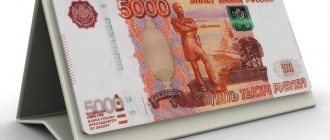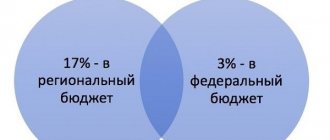Accounting for VAT on payment and shipment in 2021 has not changed. In letter No. 03-07-11/3850 dated January 24, 2019, the Ministry of Finance of the Russian Federation once again clarified how VAT is accounted for on shipment before receiving payment. Such transactions are rare, but various agreements occur in the economic life of a company. The seller is obliged to charge VAT “on shipment” or “on payment”, taking into account whichever comes first, since Art. 167 of the Tax Code of the Russian Federation determines the moment of formation of the tax base.
Therefore, the moment for determining the tax base in a “shipment without payment” situation is the day of shipment, regardless of the terms of the contract, which means that the supplier has an obligation to immediately charge tax, although payment for the transferred goods has not yet been received. In the future, when receiving funds, he will not have to recalculate the base. Let's figure out how to take into account such transactions between the supplier and the buyer.
Accounting for shipping transactions from the seller
Upon transfer of goods, the supplier's accounting records the write-off of the cost of products sold and charges VAT on the sale price. The postings will be as follows:
| Operation | D/t | K/t |
| on the date of shipment | ||
| The shipment is reflected at the cost of the goods | 45 | 41 |
| VAT charged | 76 | 68/2 |
| on the date of payment | ||
| Funds have been received from the buyer to the account | 51 | 62 |
| Revenue included | 62 | 90/1 |
| Disposal of goods in transit | 90/2 | 45 |
| When recognizing revenue, VAT accrued on sales is taken into account | 90/3 | 76 |
Example:
Rio LLC, on the basis of an agreement with Container LLC, shipped a batch of hardware worth 600,000 rubles on 03/03/2020. (including VAT 100,000 rub.). Cost of products sold – 200,000 rubles. Payment for the goods from the buyer was received on March 25, 2020. The following entries were made in the accounting of Rio LLC:
| Operation | D/t | K/t | Sum |
| as of 03/03/2020 | |||
| The transfer of hardware from the warehouse is reflected | 45 | 41 | 200 000 |
| VAT charged (600000/20 x 120) | 76 | 68/2 | 100 000 |
| VAT paid | 68/2 | 51 | 100 000 |
| as of 03/25/2020 | |||
| Payment received | 51 | 62 | 600 000 |
| Revenue taken into account at sales price | 62 | 90/1 | 600 000 |
| Write-off of the cost of goods in transit | 90/2 | 45 | 200 000 |
| VAT on goods sold is included in revenue | 90/3 | 76 | 100 000 |
Expenses
Proceeds from sales can be reduced by costs associated with production and sales (subclause 1, clause 3, article 315 of the Tax Code of the Russian Federation). Such expenses include:
- expenses associated with the manufacture (production), storage and delivery of products, performance of work, provision of services;
- expenses for maintenance and operation, repair and maintenance of fixed assets and other property, as well as for maintaining them in good condition;
- expenses for the development of natural resources;
- research and development expenses;
- expenses for compulsory and voluntary insurance;
- other costs associated with production and (or) sales.
The list of expenses by which sales revenue can be reduced is specified in paragraph 1 of Article 253 of the Tax Code of the Russian Federation.
At the same time, according to paragraph 2 of Article 253 of the Tax Code of the Russian Federation, expenses associated with production and sales are divided into groups:
- material costs;
- labor costs;
- the amount of accrued depreciation;
- other expenses.
The list of other expenses associated with production and sales is given in Article 264 of the Tax Code of the Russian Federation.
Buyer's accounting
Unpaid goods in the buyer's accounting must be credited to the off-balance account on the day they are received in accordance with clause Method of Instructions for Accounting for Inventory No. 119n dated January 28, 2001. They arrive to account 41 after payment:
| Operation | D/t | K/t |
| on the date of receipt of goods | ||
| The goods are included in the balance sheet | 002 | |
| on the date of payment | ||
| Goods paid for at purchase price | 60 | 51 |
| The item is written off from an off-balance account | 002 | |
| The goods are included in the goods account | 41 | 60 |
| VAT included | 19 | 60 |
| VAT is accepted for deduction | 68/2 | 19 |
Let's go back to the example
LLC "Container" received the goods on 03/05/2020, payment was made on 03/25/2020. These transactions were recorded in accounting as follows:
| Operation | D/t | K/t | Sum |
| as of 03/05/2020 | |||
| Hardware included in the balance sheet | 002 | 500 000 | |
| as of 03/25/2020 | |||
| Payment for hardware has been made | 60 | 51 | 600 000 |
| The cost of the goods is reflected | 41 | 60 | 500 000 |
| The cost of goods is written off from an off-balance sheet account | 002 | 500 000 | |
| VAT on purchased inventory items has been taken into account | 19 | 60 | 100 000 |
| VAT credited | 68/2 | 19 | 100 000 |
Accrual method
If an organization uses the accrual method, then it is necessary to additionally take into account the division of expenses into direct and indirect (Article 318 of the Tax Code of the Russian Federation). Expenses that reduce sales revenue in the current month are calculated using the formula:
| Expenses that reduce sales revenue in the current month | = | Indirect costs associated with production and sales | + | Direct costs associated with production and sales | – | Cost of work in progress balances at the end of the month | – | Cost of remaining finished products in warehouse at the end of the month | – | Cost of shipped but not sold products at the end of the month |
This calculation procedure is given in paragraph 2 of Article 318 of the Tax Code of the Russian Federation.
To determine the value of finished product balances in the warehouse at the end of the month, use the following method.
Determine the balance of finished products in the warehouse at the end of the month in quantitative terms (based on primary documents on movement and balances of finished products in the warehouse):
| Balance of finished products in warehouse at the end of the month (in quantitative terms) | = | Balance of finished products in warehouse at the beginning of the month | + | Number of products released during the month | – | Quantity of products shipped during the month |
Calculate the cost of finished product balances in the warehouse at the end of the month using the formula:
| Cost of remaining finished products in warehouse at the end of the month | = | Balance of finished products in the warehouse at the end of the month (in quantitative terms) | : | Balance of finished products in warehouse at the beginning of the month (in quantitative terms) | + | Number of products released during the month | × | Cost of finished products at the beginning of the month | + | Direct expenses incurred in the current month (taking into account the value of work in progress at the beginning of the month) | – | Cost of work in progress balances at the end of the month |
This procedure for determining the value of the balances of finished products in the warehouse at the end of the month is established by paragraph 2 of Article 319 of the Tax Code of the Russian Federation.
To determine the cost of shipped but not sold products at the end of the month, use the following algorithm.
First, calculate the direct costs attributable to products shipped in the current month:
| Direct costs attributable to products shipped in the current month | = | Cost of finished products at the beginning of the month | + | Direct expenses incurred in the current month (taking into account the value of work in progress at the beginning of the month) | – | Cost of work in progress balances at the end of the month | – | Cost of remaining finished products in warehouse at the end of the month |
Determine the cost of shipped but not sold products at the end of the month using the formula:
| Cost of shipped but not sold products at the end of the month | = | Quantity of products shipped but not sold at the end of the month (based on data from primary documents) | : | Quantity of products shipped | × | Cost of shipped but not sold products at the beginning of the month | + | Direct costs attributable to products shipped in the current month |
This procedure is established by paragraph 3 of Article 319 of the Tax Code of the Russian Federation.
An example of determining in tax accounting expenses that reduce revenue from sales of own-produced products. The organization uses the accrual method
LLC "Proizvodstvennaya" is engaged in the production of office cabinets. Applies the accrual method.
At the beginning of January 2013, the value of work in progress balances amounted to 2,000 rubles.
The balance of finished products in the warehouse at the beginning of the month was 4 pieces. The cost of the remaining finished products in the warehouse is 20,000 rubles.
The number of shipped but not sold products at the beginning of the month was 12 pieces. The cost of shipped but not sold products at the beginning of the month amounted to 60,000 rubles.
The amount of direct costs for production and sales in January amounted to 150,000 rubles. The organization produced 70 cabinets this month. Of these, 50 pieces were shipped (including 47 pieces sold).
The cost of the balance of work in progress at the end of the month amounted to 5,000 rubles.
The accountant calculated the balance of finished products at the end of January as follows: 4 pcs. + 70 pcs. – 50 pcs. = 24 pcs.
The cost of the remaining finished products in the warehouse at the end of the month was determined by the accountant as follows: 24 pcs. : (4 pcs. + 70 pcs.) × (2000 rub. + 20,000 rub. + 150,000 rub. – 5,000 rub.) = 54,162 rub.
Direct costs attributable to shipped products amounted to: RUB 20,000. + 2000 rub. + 150,000 rub. – 5000 rub. – 54,162 rub. = 112,838 rub.
The accountant calculated the cost of shipped but not sold products at the end of the month as follows: (12 pcs. + 50 pcs. – 47 pcs.): (12 pcs. + 50 pcs.) × (60,000 rub. + 112,838 rub.) = RUB 41,816
Income (revenue) from sales in January amounted to 300,000 rubles.
Indirect costs associated with production and sales - 10,000 rubles.
The accountant calculated the amount of expenses associated with production and sales, which will reduce sales revenue in January: 10,000 rubles. + (150,000 rub. – 5,000 rub. – 54,162 rub. – 41,816 rub.) = 59,022 rub.
Accounting for VAT on shipment before receiving payment in different periods
The letter of the Ministry of Finance of the Russian Federation No. 03-07-11/7135 dated March 11, 2013 reflects the opinion: if the shipment is made in one reporting period, and the ownership (more often this happens with the transfer of payment) is transferred to the buyer in another, then VAT is charged during the period of shipment and at the tax rate in force for that period.
For example, if the shipment was made in 2021, and payment was made in 2020, VAT should be charged on the day of actual shipment in 2019. The tax base is calculated in accordance with the provisions of Art. 154 of the Tax Code of the Russian Federation - from the cost of the goods sold excluding taxes. That is, if the selling price of a product is 10,000 rubles, then it is subject to VAT. The seller prepares an invoice for the shipped goods, regardless of the fact of receipt of payment, and sends it to the buyer. When transferring payment for goods in 2021, the tax will no longer be recalculated.
In the seller's accounting, VAT, accrued and presented to the buyer before the recognition of sales proceeds, may be reflected, for example, in the account. 45 or on account. 76/VAT. On the date of revenue recognition, VAT is written off from accounts 45 or 76/VAT to the debit of account 90/3. The postings in supplier accounting will be the same as in the example above.
If the buyer receives ownership of the goods at the time of its transfer, then even for unpaid goods in transit, he has the right to claim a tax deduction. Moreover, if the transaction is completed at the turn of two periods, and the buyer attributes the amount of VAT accrued by the seller on the invoice to the shipment period, there will be no error in this.
Revenues from sales
Income from the sale of manufactured products (works, services) is revenue (clause 1 of Article 249 of the Tax Code of the Russian Federation).
How to determine its amount, see How to determine sales revenue in tax accounting. Situation: what documents confirm the sale of products (works, services) in tax accounting?
The fact of sale in tax accounting is confirmed by primary documents (Article 313 of the Tax Code of the Russian Federation). In particular, such documents may be an acceptance certificate for completed work, an act for the provision of services, a delivery note and other documents.
It should be noted that for customers who calculate income tax using the accrual method and include the cost of work performed for them (services provided to them) as part of material expenses, the presence of an acceptance certificate for the work performed (service provision certificate) is mandatory. Contractors should take these conditions into account and draw up such acts at the request of customers.
The forms of primary documents can be approved by the head of the organization (Part 4 of Article 9 of the Law of December 6, 2011 No. 402-FZ). Moreover, they must contain the mandatory details provided for in Part 2 of Article 9 of the Law of December 6, 2011 No. 402-FZ. To ensure uniformity of document flow, the Federal Tax Service of Russia develops electronic formats for the most common primary documents and recommends their use in practice. In particular, electronic formats of the consignment note and the act of completion of work (rendering services) were approved by orders of the Federal Tax Service of Russia dated November 30, 2015 No. ММВ-7-10/551 and No. ММВ-7-10/552.
The forms of primary documents developed by the organization independently must be fixed in the accounting policy for accounting purposes (Part 1, Article 8 of the Law of December 6, 2011 No. 402-FZ). They can also be used to confirm income and expenses when taxing profits. This follows from the provisions of Article 313 of the Tax Code of the Russian Federation.
The moment when proceeds from sales are included in the income tax base depends on the method of determining income and expenses that the organization uses (clause 2 of Article 249 of the Tax Code of the Russian Federation).
Value added tax (VAT) in 2021
The amount of VAT received from the buyer is paid by the seller to the budget and is determined by him as the difference between the amount of tax calculated by him when selling goods (work, services, property rights) to buyers, and the amount of tax presented to this taxpayer when he purchased goods (work, services) , property rights) used for VAT-taxable transactions.
This rate applies to the sale of certain food and medical products, goods for children and printed publications. A specific list of goods, the sale of which is subject to VAT at a rate of 10%, is indicated in clause 2 of Art. 164 Tax Code of the Russian Federation.
We suggest you read: What threatens if there is a suspended sentence when initiating a new case
VAT - only on shipment
It turns out that all companies that currently charge VAT “on payment” will have to calculate the tax in a new way from 2006. How should such companies deal with VAT on goods shipped but not paid for by the end of 2005?
— Indeed, when applying the “on shipment” principle, receipt of payment for future deliveries is not exempt from taxation, but at the same time it was decided to exempt exporters receiving advances and enterprises producing products with a long production cycle (subject to deferred tax deduction) on material resources until the end of the production process).






